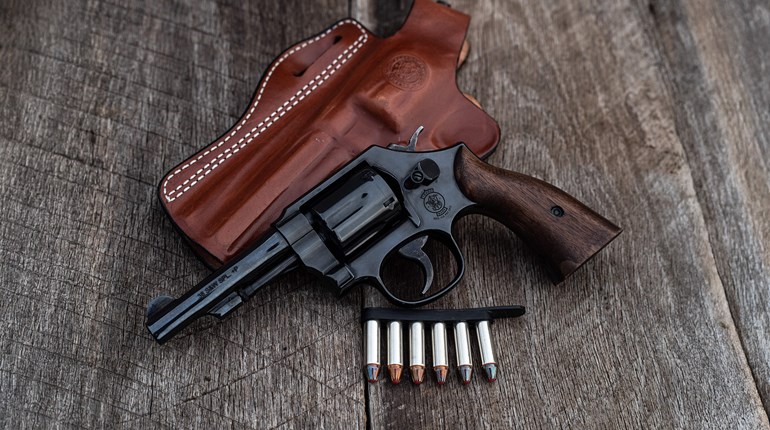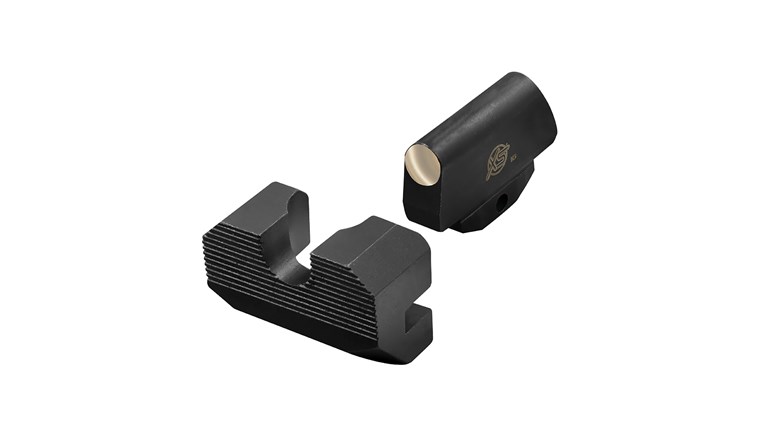
Before we get into the features of the Charter Arms Bulldog XL, let's get a few background details out of the way. The founder of Charter Arms, a guy by the name of Douglas McLenahan, had been an engineer working at established gun makers like Colt and Ruger before setting out on his own. Possibly apocryphally, he had offered up his ideas for an improved double-action revolver at his old employers, only to have them rejected.
The initial offering from Charter Arms was the Undercover, an outwardly conventional-looking, five-shot, snubnose, small-frame, .38 Spl. revolver. A closer inspection revealed plenty of innovations in manufacturing, however, that in theory made the revolver lighter, stronger and cheaper to manufacture.
The Undercover was followed in 1973 by the Bulldog, which was only slightly larger and chambered in .44 Spl. This was a bold way for Charter Arms to signal the strength of their small-frame revolver, since at the time the .44 Special wasn’t available in anything but large-frame Smith & Wessons or cowboy-style, single-action guns.

Charter Arms has gone through a few iterations since then, but their current owners are now showing off the strength of the basic Charter design by upsizing the Bulldog to the Bulldog XL model, which is chambered in .45 Colt.
The most noticeable feature of the Charter design is the absence of a sideplate. Conventional Colt and Smith & Wesson revolvers with swing-out cylinders start with a frame forging and then a sort of pocket is machined into the frame forging to contain the lockwork. This hole is then covered with a plate that is precisely machined and fitted to cover it; the sideplate.

This is a time-consuming manufacturing step that McLenahan avoided by having the lockwork fork up into the frame from below, secured in place by a removable separate one-piece trigger guard/gripframe assembly, in a manner reminiscent of the old single-action Colts.
In addition to making manufacturing less expensive, this also meant that from the front of the frame where the barrel screwed in to the rear of the frame behind the hammer was all of a piece with no pocket machined away for the lockwork.
In another departure from current practices by the older manufacturers, the Charter Arms Bulldog XL design has the crane, the swing arm that holds the cylinder, protected in front by the frame. On a Colt or Smith, the crane is exposed.
The Bulldog XL features a shrouded ejector rod, so that a freak drop accident won’t result in a bent ejector rod which would render the gun non-functional.
The reason for the XL being an entirely different model, as opposed to just a different chambering than the existing Bulldog is that the Bulldog was pretty well minimally sized for the .44 Spl. cartridge. The move to .451-inch bullets from .429-inch ones meant a larger cylinder, and that called for a slightly larger frame. There’s still a family resemblance, but the XL variant is noticeably swollen compared to its little brother.

The unusual construction of the Charter Arms Bulldog results in a lightweight gun. The 2.5-inch barreled Bulldog XL tipped my scale at 22 ounces empty and 26 ounces with a cylinder full of 225-grain Winchester Silvertips. By contrast, my personal 2-inch Smith & Wesson Model 64, a similarly-sized six-shot .38 Spl., weighed in at 33 ounces fully loaded. That’s a good half-pound heavier.
At the range, we tried the gun with 200-grain Fiocchi cowboy load lead, flat-point ammo, CCI Blazer 200-grain Gold Dot hollow points, 225-grain Winchester Silvertips, and 250-grain Magtech flat-point cowboy ammo.
The 200-grain and 225-grain ammo shot point-of-aim/point-of-impact out to 15 yards, although the Silvertips had a bunch of muzzle flash and noticeably worse recoil.
The 250-grain loads recoiled enough to be uncomfortable to shoot. Rarely did anybody feel like putting more than a cylinder or two through at one sitting. That’s okay, though, because at anything past 5 yards, where the 250-grain bullets landed relative to the sight picture was pretty much random. In my experience with smaller-framed, big-bore revolvers, they rarely play well with heavier bullets.
Unlike tests where I put as much as a couple of cases of ammo through a gun, this one was finished up with 170 rounds fired. Unless one reloads, .45 Colt is super expensive and at any rate, a hard-recoiling, compact, lightweight, defensive revolver like the Charter Arms Bulldog XL is unlikely to see thousands upon thousands of rounds fired in competition and classes.

The gun only had one true functional issue: .45 Colt is known for its very narrow rims and demands good ejection habits in a double-action wheelgun to keep the ejector from popping over the rim and tying up the gun with a spent case under the star. Fortunately this did not occur at any point in our test. However once we did have a spent case get fouled on the rubber grips, which are clearanced to prevent this from happening, but apparently not clearanced enough.
The trigger is heavy, which is to be expected from a factory double-action pull on a small revolver, but it’s also gritty. This will polish out with use, and had indeed noticeably smoothed by the end of the test, Until it does, it’s a reminder that this gun has an MSRP of $433 and street prices even lower than that.
If you want a compact .45 Colt revolver, however, the Charter Arms Bulldog XL is currently the only game in town that doesn’t come with a cylinder distended to accept shotshells.




































